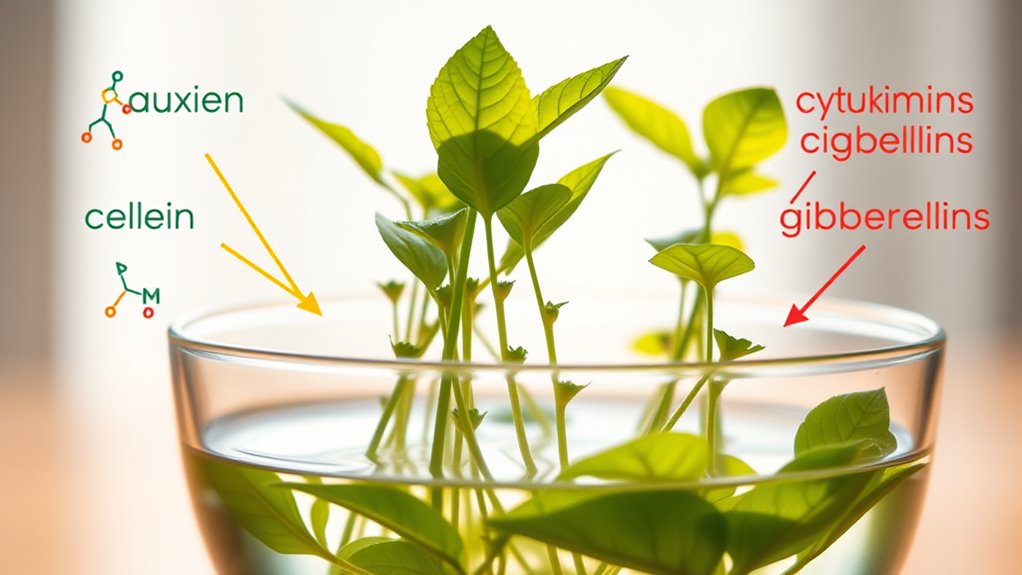Plant hormones like auxins, cytokinins, and gibberellins act as chemical messengers that regulate your plant’s growth and responses. Auxins, made in shoot tips, guide cell elongation and root development through concentration gradients. Cytokinins, produced mainly in roots, promote cell division and delay aging. Gibberellins, coming from young tissues, boost stem growth and seed germination. Keep exploring to discover how these hormones coordinate plant life perfectly.
Key Takeaways
- Auxins, mainly produced in shoot tips, regulate cell elongation and form concentration gradients that influence growth patterns.
- Cytokinins, synthesized in roots, promote cell division and delay aging, coordinating growth between roots and shoots.
- Gibberellins, formed in young tissues, stimulate stem elongation, seed germination, and flowering by activating growth-related pathways.
- Plant hormones are synthesized through tightly regulated processes and travel via signaling pathways to specific cells.
- These hormones work together to coordinate plant development and adapt to environmental changes effectively.

Have you ever wondered how plants grow, develop, and respond to their environment? The secret lies in a complex system of plant hormones—tiny chemical messengers that coordinate growth, adaptation, and survival. These hormones are produced through hormone synthesis, a carefully regulated process that guarantees plants respond appropriately to their surroundings. Once synthesized, hormones travel through signaling pathways that relay messages to specific cells, triggering desired responses like cell elongation, division, or differentiation.
Understanding hormone synthesis is key to grasping how plants control their development. For example, auxins are primarily synthesized in the shoot tips and young leaves. This production is tightly regulated, allowing plants to adapt their growth based on environmental cues. Once produced, auxins move through plant tissues via active transport mechanisms, creating concentration gradients that influence cell behavior. These gradients are essential because they activate specific signaling pathways inside cells, leading to responses like root elongation or fruit development.
Auxin production in shoot tips guides plant growth through concentration gradients and signaling pathways.
Cytokinins, another indispensable group of plant hormones, are mainly synthesized in the roots and transported upward through the xylem. Their synthesis responds to the plant’s needs, such as promoting cell division or delaying aging. When cytokinins reach target tissues, they bind to receptor proteins on cell surfaces or inside the cell, initiating signaling pathways that promote growth. These pathways involve a cascade of molecular interactions, ultimately turning on genes responsible for cell proliferation and differentiation. This precise signaling enables plants to coordinate growth between roots and shoots, ensuring balanced development.
Gibberellins, produced in young tissues like seed embryos and meristems, play a significant role in promoting stem elongation, seed germination, and flowering. Their synthesis is influenced by environmental factors like light and temperature, aligning growth with favorable conditions. Once synthesized, gibberellins activate signaling pathways that result in the breakdown of growth-restraining proteins and the activation of genes promoting cell expansion and division. This hormone signaling is essential for plants to quickly adapt their growth patterns, especially during critical stages like germination. Additionally, hormone synthesis involves precise regulation, which ensures that growth responses are appropriately timed and scaled according to developmental needs.
Frequently Asked Questions
How Do Plant Hormones Interact With Environmental Stresses?
You can see that plant hormones play a key role in stress signaling during environmental stresses. When stress occurs, hormones like abscisic acid activate adaptive responses, helping the plant survive. They regulate processes such as closing stomata and altering growth patterns. By coordinating these responses, hormones guarantee the plant adapts effectively, maintaining health and growth despite challenging conditions.
Can Plant Hormones Be Used to Enhance Crop Yields Intentionally?
Imagine revealing nature’s secret recipe for abundance. You can harness plant hormones through targeted hormone application or even genetic modification to boost crop yields. These methods act like a gentle push, encouraging plants to grow stronger, faster, and more resilient. By intentionally manipulating hormones, you turn farming into an art, enhancing productivity while reducing resources. It’s a powerful tool to help feed a growing world with smarter, sustainable solutions.
Are There Synthetic Versions of Plant Hormones Available Commercially?
You’ll find that synthetic hormones are indeed available commercially. Manufacturers produce synthetic hormone formulations like auxin, cytokinin, and gibberellin analogs, which you can use to promote plant growth, root development, or fruiting. These synthetic hormones are widely used in agriculture and horticulture to enhance crop yields, improve plant quality, and manage growth. Always follow application guidelines, as misuse can negatively affect plant health or the environment.
How Do Plant Hormones Influence Flowering and Fruiting Processes?
Perfectly pondering plant processes, you’ll find hormones heavily influence flowering regulation and fruit development. Auxins promote fruit setting, while cytokinins encourage cell division, aiding flowering. Gibberellins boost stem growth and flowering signals. Together, these hormones harmonize to help plants shift from budding to blooming, and then to bountiful fruiting. Understanding this hormonal harmony lets you manipulate growth, encouraging lush blossoms and fruitful harvests with strategic stimulation.
What Are the Long-Term Effects of Hormone Treatments on Plants?
When you use hormone treatments long-term, you might face hormone resistance, where plants stop responding effectively. This can limit growth or flowering, reducing crop yields. Additionally, repeated treatments could lead to genetic modifications over time, intentionally or not, affecting plant stability. To avoid these issues, you should monitor plant responses carefully and consider integrated strategies, balancing hormone use with other cultivation practices for healthier, more resilient plants.
Conclusion
Now that you understand auxins, cytokinins, and gibberellins, you see how they work together to guide plant growth. They control cell division, elongation, and differentiation, shaping roots, stems, and leaves. By grasping their roles, you can appreciate how plants respond to their environment, adapt, and thrive. These hormones are the keys to life’s green miracle, empowering you to open the secrets of plant development and nurture healthier, stronger plants every day.










